Abstract
When the Stockholm and 468C strains of type C and the 1873 strain of type D Clostridium botulinum are „cured” of their prophages, they simultaneously discontinue the production of their dominant toxins (C1 and D), but they continue to produce a second antigenically monospecific toxin (C2). These „cured” strains of types C and D therefore become indistinguishable with respect to the toxin produced. Fifteen type C cultures received from other laboratories discontinued to produce the dominant toxin when subcultured in broth. The C2 toxin, however, was produced by eight of these cultures. The C2 toxin is produced by these cultures as a protoxin that requires treatment with trypsin before its toxicity can be demonstrated. Of the 21 type C cultures that produce the C1 toxin, 20 were shown to produce the C2 toxin. The filtrates of 14 of these cultures required trypsin treatment before the C2 toxicity could be demonstrated. Low levels of toxicity could be demonstrated in the six remaining culture fluids without trypsin; toxicity, however, was increased with trypsin.
Full text
PDF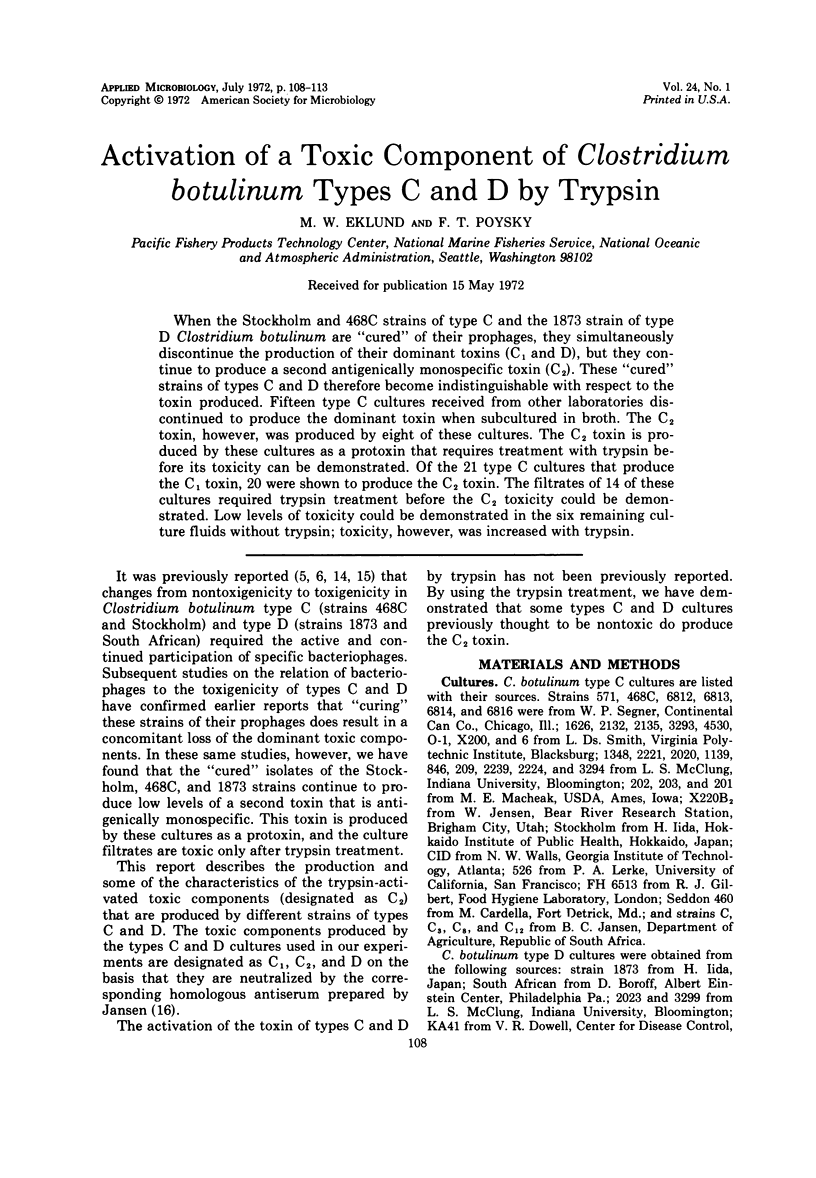
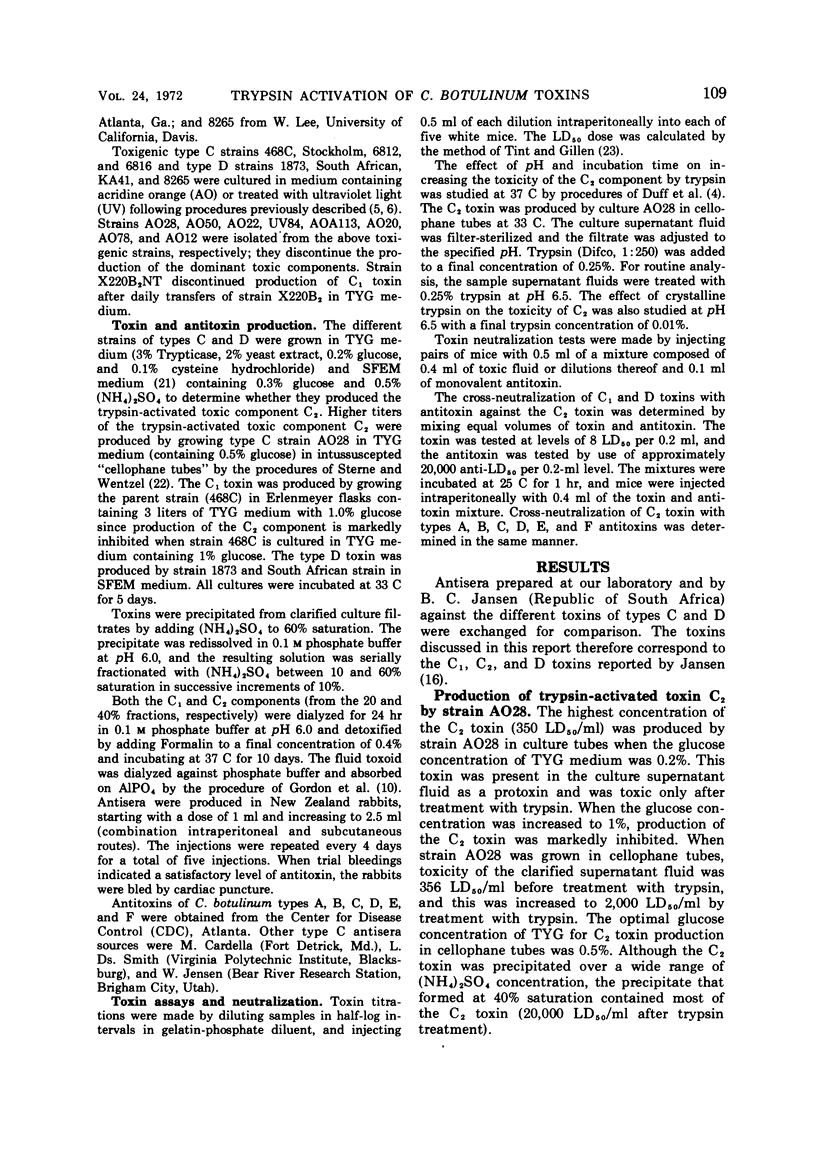
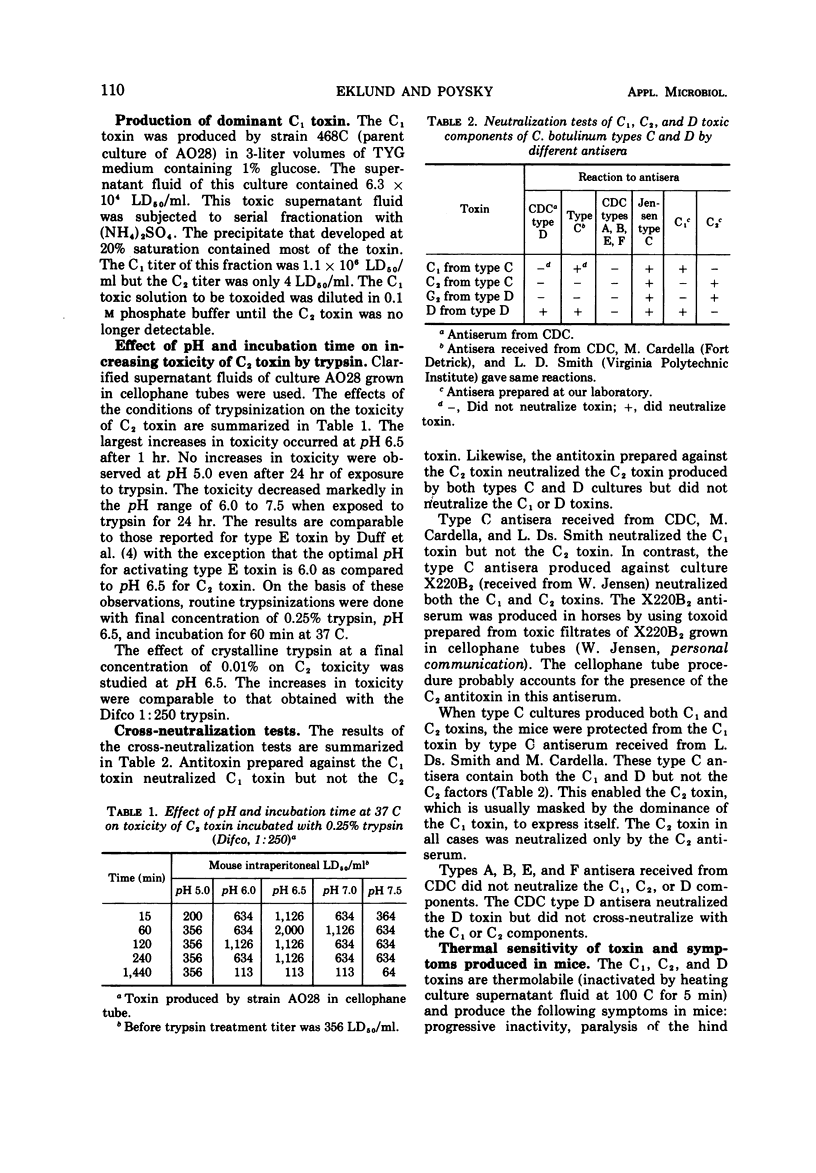
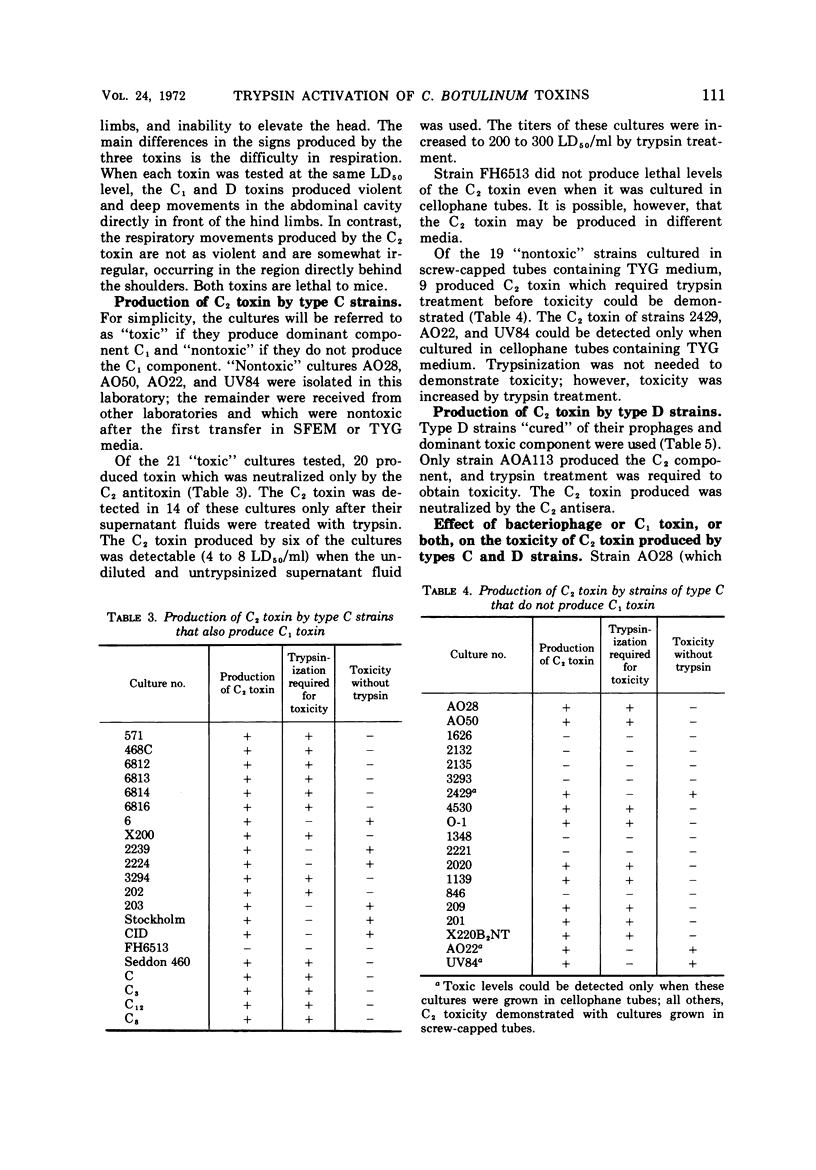
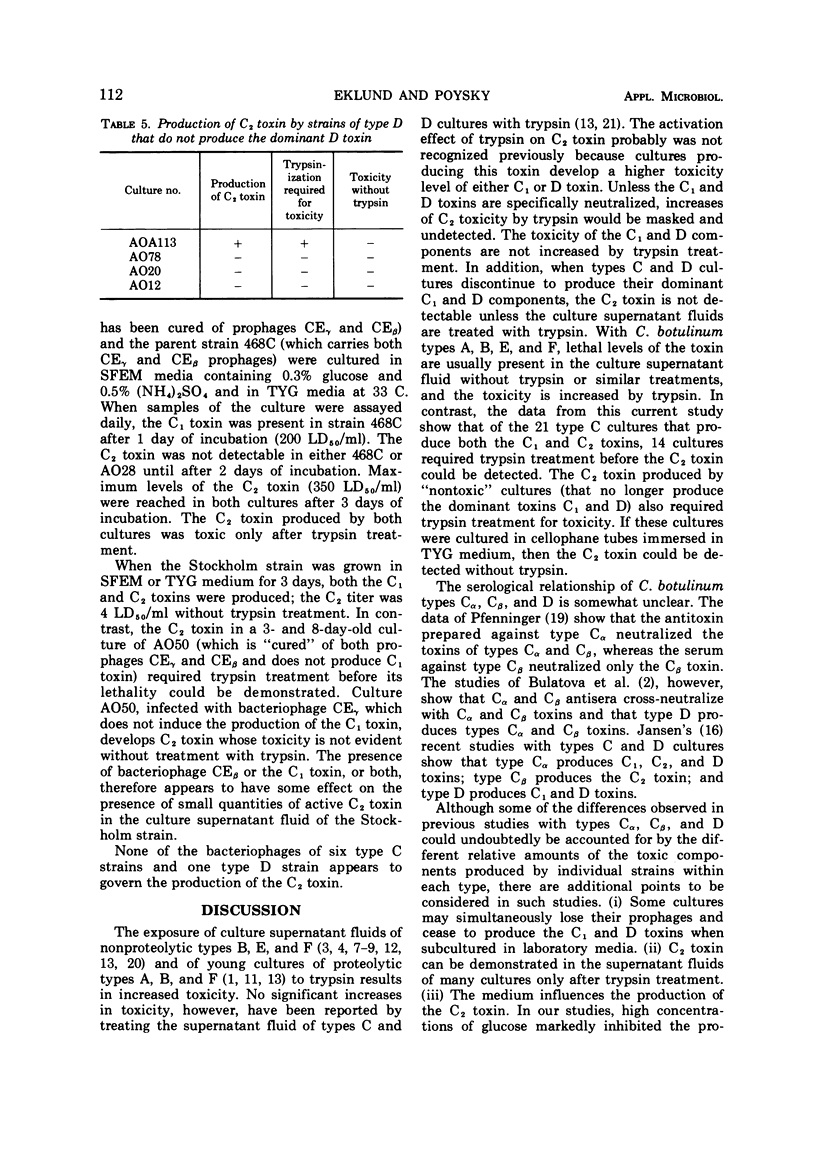
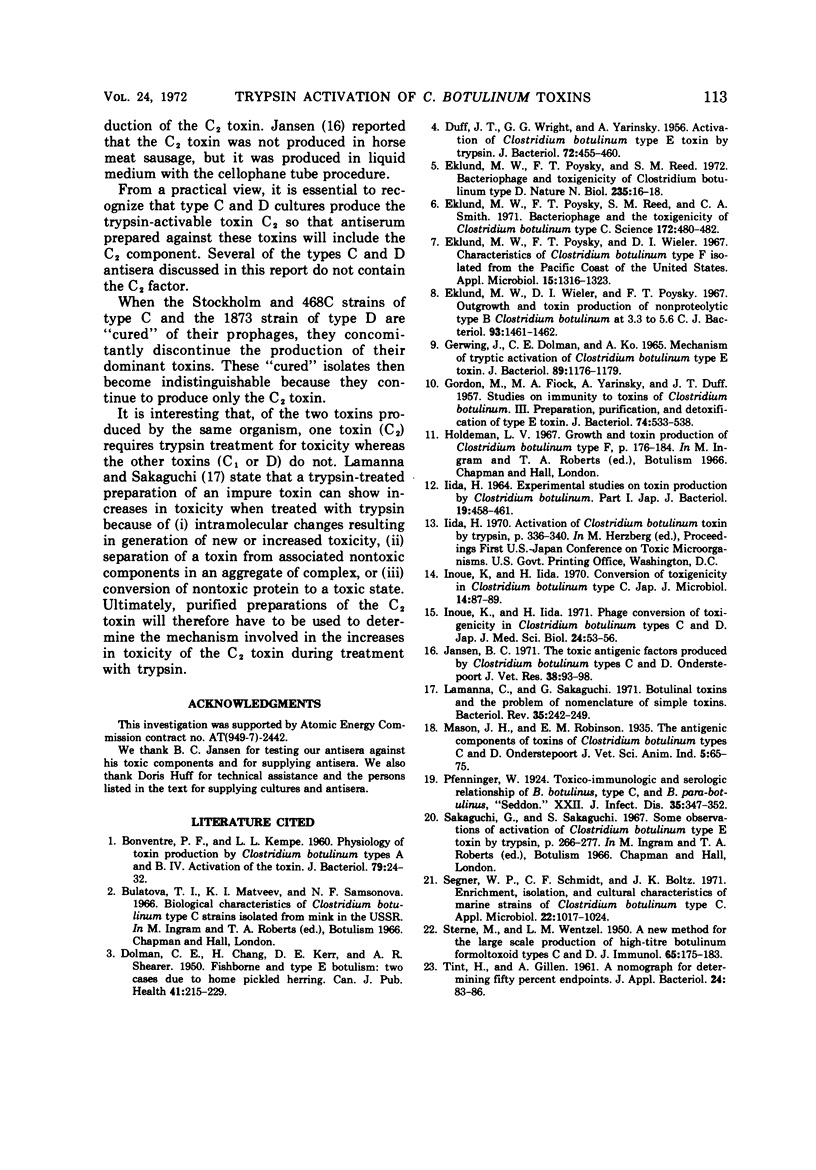
Selected References
These references are in PubMed. This may not be the complete list of references from this article.
- BONVENTRE P. F., KEMPE L. L. Physiology of toxin production by Clostridium botulinum types A and B. IV. Activation of the toxin. J Bacteriol. 1960 Jan;79:24–32. doi: 10.1128/jb.79.1.24-32.1960. [DOI] [PMC free article] [PubMed] [Google Scholar]
- DOLMAN C. E., CHANG H., KERR D. E., SHEARER A. R. Fish-borne and type E botulism: two cases due to home-pickled herring. Can J Public Health. 1950 Jun;41(6):215–229. [PubMed] [Google Scholar]
- DUFF J. T., WRIGHT G. G., YARINSKY A. Activation of Clostridium botulinum type E toxin by trypsin. J Bacteriol. 1956 Oct;72(4):455–460. doi: 10.1128/jb.72.4.455-460.1956. [DOI] [PMC free article] [PubMed] [Google Scholar]
- Eklund M. W., Poysky F. T., Reed S. M. Bacteriophage and the toxigenicity of Clostridium botulinum type D. Nat New Biol. 1972 Jan 5;235(53):16–17. doi: 10.1038/newbio235016a0. [DOI] [PubMed] [Google Scholar]
- Eklund M. W., Poysky F. T., Reed S. M., Smith C. A. Bacteriophage and the toxigenicity of Clostridium botulinum type C. Science. 1971 Apr 30;172(3982):480–482. doi: 10.1126/science.172.3982.480. [DOI] [PubMed] [Google Scholar]
- Eklund M. W., Poysky F. T., Wieler D. I. Characteristics of Clostridium botulinum type F isolated from the Pacific Coast of the United States. Appl Microbiol. 1967 Nov;15(6):1316–1323. doi: 10.1128/am.15.6.1316-1323.1967. [DOI] [PMC free article] [PubMed] [Google Scholar]
- Eklund M. W., Wieler D. I., Poysky F. T. Outgrowth and toxin production of nonproteolytic type B Clostridium botulinum at 3.3 to 5.6 C. J Bacteriol. 1967 Apr;93(4):1461–1462. doi: 10.1128/jb.93.4.1461-1462.1967. [DOI] [PMC free article] [PubMed] [Google Scholar]
- GERWING J., DOLMAN C. E., KO A. MECHANISM OF TRYPTIC ACTIVATION OF CLOSTRIDIUM BOTULINUM TYPE E TOXIN. J Bacteriol. 1965 May;89:1176–1179. doi: 10.1128/jb.89.5.1176-1179.1965. [DOI] [PMC free article] [PubMed] [Google Scholar]
- GORDON M., FIOCK M. A., YARINSKY A., DUFF J. T. Studies on immunity to toxins of Clostridium botulinum. III. Preparation, purification, and detoxification of type E toxin. J Bacteriol. 1957 Oct;74(4):533–538. doi: 10.1128/jb.74.4.533-538.1957. [DOI] [PMC free article] [PubMed] [Google Scholar]
- Inoue K., Iida H. Conversion of toxigenicity in Clostridium botulinum type C. Jpn J Microbiol. 1970 Jan;14(1):87–89. doi: 10.1111/j.1348-0421.1970.tb00495.x. [DOI] [PubMed] [Google Scholar]
- Inoue K., Iida H. Phage-conversion of toxigenicity in Clostridium botulinum types C and D. Jpn J Med Sci Biol. 1971 Feb;24(1):53–56. [PubMed] [Google Scholar]
- Jansen B. C. The toxic antigenic factors produced by Clostridium botulinum types C and D. Onderstepoort J Vet Res. 1971 Jun;38(2):93–98. [PubMed] [Google Scholar]
- Lamanna C., Sakaguchi G. Botulinal toxins and the problem of nomenclature of simple toxins. Bacteriol Rev. 1971 Sep;35(3):242–249. doi: 10.1128/br.35.3.242-249.1971. [DOI] [PMC free article] [PubMed] [Google Scholar]
- STERNE M., WENTZEL L. M. A new method for the large-scale production of high-titre botulinum formol-toxoid types C and D. J Immunol. 1950 Aug;65(2):175–183. [PubMed] [Google Scholar]
- Segner W. P., Schmidt C. F., Boltz J. K. Enrichment, isolation, and cultural characteristics of marine strains of Clostridium botulinum type C. Appl Microbiol. 1971 Dec;22(6):1017–1024. doi: 10.1128/am.22.6.1017-1024.1971. [DOI] [PMC free article] [PubMed] [Google Scholar]


